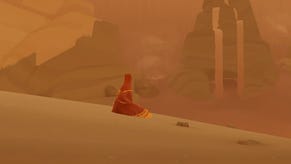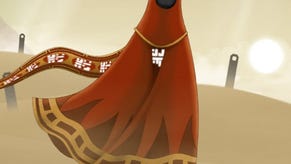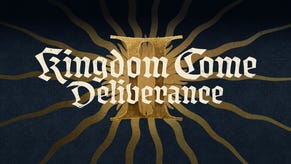Once upon a time: how Journey nearly became an MMO
Journey took the path less traveled on its way to becoming a bestselling adventure. Nathan Grayson sojourns with thatgamecompany's Jenova Chen and Robin Hunicke.
The modern world is kind of totally amazing. Sitting alone in my room – wrinkled, ill-fitting clothes thankfully only glimpsed by the sunlight peeking through my window – I feel like a cyberpunk super spy. At the click of a mouse, countless RSS feeds, Twitter apps, Facebook pages, Tumblrs, Flickrs, and Purple Monkey Dishwashrs overload my brain with information until it nearly short circuits. I have up-to-the-millisecond knowledge of all my favorite people, TV shows, memes that stopped being funny three years ago, and, yes, video games.
And yet, despite how things may appear, modern game development isn't an open book. Whether it's because game developers are perfectionists or players recoil in sputtering revulsion at even the tiniest fleck of naked flesh that proves these people aren't flawless game-making robots, our industry is obsessed with the very bottom of the bottom line. Countless games get canceled or revamped halfway through development because they're too risky or not good enough, and we never hear a peep about them.
But isn't that weird? How does anyone learn if not from their own mistakes and the mistakes of others? To package anything – product, piece of art, weight loss product, whatever – otherwise is, on some level, a coolly calculated lie. So I spoke with thatgamecompany in hopes of chipping away some of the makeup and studying the warts underneath.
Following footsteps
Journey's been heralded as a triumph of experimental gameplay, but it began miles upon miles away from that point. In truth, if not for a number of twists and turns in development, it would've ended up as a far more traditional game. Its focus on very close, personal interactions, for instance, actually had its genesis in an idea about as far from one-on-one as you can get: massively multiplayer online role-playing.
“It was probably in 2006, when I was graduating from grad school,” thatgamecompany co-founder Jenova Chen explained to VG247.
“I had this class where they taught us about the Hero's Journey, which is Joseph Campbell's concept. At that time, we were actually thinking about making Journey an MMO game, with hundreds and thousands of players online, they're all someone lost in this mountain trying to get to the top.”
And though that idea didn't stick for long, other elements of MMO design crept onto Journey's development path. In those cases, it was tempting to take the easy way out and do things by the book. But the easy way isn't always the right one, and oftentimes, it's not even actually easy. The key, however, is to know your limits, and Journey's limits became its biggest strength.
"The headsets, it’s kind of hard to set up, and the other problem is… If you hear a 12-year-old on the other side, it really takes you out of the game."
“Initially, when we worked on it, we wanted to have chat,” admitted Chen. “We wanted to have friend invites and text. But then what happens is, very quickly we realized a very small amount of people would actually hook a keyboard to the PlayStation.
"If it were a computer game, it would feel natural to chat with text. And then the headsets, it's kind of hard to set up, and the other problem is... If you hear a 12-year-old on the other side, it really takes you out of the game.”
“It is an accident, the fact that we embraced this constraint. But we discovered benefits from it that we wouldn't have thought of. The fact that you can keep the player immersed in the world, even while playing with another player – he still can't take you out of this world, because he can't speak.
"It's kind of amazing immersion for an online experience. Usually when I'm playing an online game, like World of Warcraft, most of the time I spend talking about things outside the game. But in Journey it's all about the game.”
Taking the high road
So Journey evolved into a planetary alignment of platforming, adventure, and super snazzy scarves, but its elegant simplicity wasn't always part of the picture. It's odd (and a bit frightening) to think about, but Journey could have easily ended up resembling one of the everything-and-the-kitchen-sink-collecting-minigame titles it now finds itself so convincingly arguing against.
“We had a lot of... I don't know what you would call it – for lack of a better word – Ice Climber or switch-based mechanics,” explained former thatgamecompany executive producer Robin Hunicke.
“One person would have to go to one side, one person would have to go to the other side, and you'd both have to do something at the same time. They were very traditional classic co-op platform or adventure game mechanics. But one of the things that we realized after we'd implemented them is that it doesn't feel real to be connected to somebody if you're forced to hold hands or you're forced to coordinate pushing a switch. It feels game-y.”
“It's kind of like this concept of flow,” added Chen. “Flow, in order to be in flow, a person has to feel willing to engage. What happens in some of your co-op games is that when people are not ready to engage, they start to game the system.
"One of the oldest games you could remember would be Tanks. You're supposed to play until you kill the enemy tanks. But people would just start shooting each other to get kills. That's a typical thing. Even in Left 4 Dead, where the premise is you're supposed to help each other, what happens is, eventually there are people who like to team kill. Then they just kill you when they think it's safe.”
Unfortunately, Chen did not end up naming Journey “Flowest” – despite an entire game-naming career to the contrary. His latest opus did, however, ultimately continue thatgamecompany's love affair with that concept. This time, though, the focus was on looking just as far back as the likes of flOw and Flower did forward.
“We experimented a lot with what we would consider to be traditional mechanics because we hadn't actually built them into a game before,” noted Hunicke. “But in many cases we would decide either to significantly reduce their presence or change them in a way that would make them more open.
"They all fell into the one single rule, which is the player can choose to collaborate, but they never have to. That’s pretty much Journey. When they do collaborate, it is all from the genuine collaboration.”
"And also, because Journey is something where – at any point in the experience – you need to be open to accepting another player into the design, it also made the design very constrained in some ways. Very specific things that you would imagine would be in the game were quite difficult because we couldn't guarantee that a person would be there from the beginning to the end, or wouldn't come in the middle of the experience.”
“They all fell into the one single rule, which is the player can choose to collaborate, but they never have to,” added Chen. “That's pretty much Journey. When they do collaborate, it is all from the genuine collaboration. It's more likely you will have a good connection with them.”
Only one way up
Journey, then, came a long, long way – from bloated, shapeless mass of ideas to convention-piercing point honed by restraint and careful study. Typically, though, we don't see games like Journey until the marketing machine's begun its eerily robotic song and dance, and that's kind of a shame. Perfection's overrated. People tend to learn very little when they reach their destination without a hitch. Even so, there's something to be said for finally, breathlessly crossing the finish line.
“I think Jenova and I were both in tears a little bit reading reviews from people that said they had personal experiences, whether as developers or as journalists,” Hunicke said. “They were so embittered that they hadn't even realized about online play or playing with other people, but they had a genuine connection with someone else. That made my life.
"It's so rare that you get to have that kind of an opportunity to really touch someone who's become jaded and hardened to the beauty of another person. That, to me, was the ultimate, the zenith. I don't think there's anything better than that. That was so awesome.”
Journey is available for download from the PlayStation Network; it is the service's fastest-selling title.















.jpg?width=291&height=164&fit=crop&quality=80&format=jpg&auto=webp)


